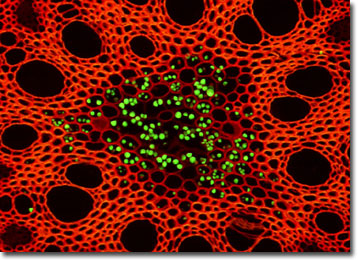Fluorescence Digital Image Gallery
Smilax Root
In the familiar folktale about tar baby, Brer Rabbit cleverly tricks his captor into throwing him into the briar patch that is his happy home, rather than inflicting him with some other type of bodily harm. At the crux of this ruse is Brer Rabbit's knowledge that Brer Fox could not believe that someone would actually want to be placed in a dense thicket of thorny vines.

Similarly, the prickly, sprawling plants of the genus Smilax often seem a nuisance to humans who can easily get caught in their thorns, though they are a highly desirable habitat for birds and a variety of small mammals. These creatures are diminutive enough to safely navigate between the branches and tendrils of the plants, which provide them with protective shelter from larger animals. Also, Smilax vines, often alternatively referred to as catbriers or greenbriers, produce shiny dark berries that serve as an important food source for various types of wildlife.
Though the thorns of Smilax vines may seem particularly uninviting to humans, the perennial plants have been exploited in various societies throughout history. The young shoots of some species, for instance, may be safely consumed and are said to have a taste similar to that of asparagus, a plant which shares their status as members of the lily family Liliaceae. Other types of Smilax plants, however, have been more often used for medicinal purposes, rather than as a type of food. Smilax officinalis, for example, was sometimes utilized by the indigenous tribes of the Americas as a diuretic, a stimulant, and an aphrodisiac, later gaining a reputation as a treatment for sexually transmitted diseases. Also known as sarsaparilla, extracts from the roots of the plant are still believed by many to have curative properties and may be found in a wide variety of nutritional supplements.
BACK TO THE FLUORESCENCE DIGITAL IMAGE GALLERY
